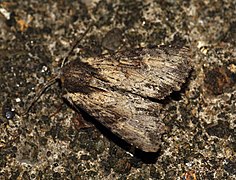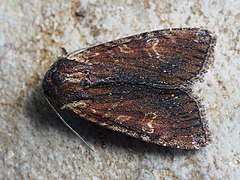Large mutable tussock owl
| Large mutable tussock owl | ||||||||||||
|---|---|---|---|---|---|---|---|---|---|---|---|---|

Great changeable tufted owl ( Apamea crenata ) |
||||||||||||
| Systematics | ||||||||||||
|
||||||||||||
| Scientific name | ||||||||||||
| Apamea crenata | ||||||||||||
| ( Hufnagel , 1766) |
The great variable grass tufted owl ( Apamea crenata , synonym : Hadena rurea ), sometimes to be found in the literature as Phalaena crenata , is a butterfly ( moth ) from the family of the owl butterfly (Noctuidae).
features
butterfly
The wingspan of the moth is 33 to 44 millimeters. They are very variable in terms of color. The basic color of the upper side of the forewing varies from yellow-brown to reddish brown to dark brown. Kidney and ring flaws are usually clearly developed and have a whitish or brown border, but the transverse lines are often indistinct. Sometimes dark brown arrow spots stand out on the outer edge . The upper side of the hind wings is a single color, light gray-brown.
Caterpillar, pupa
Adult caterpillars are colored brown-gray to earth-gray. They show a yellow-white topline. There are black spots and point warts of the same color on each body segment. The side stripe is yellow-white. The head, pronotum and anus are black-brown. Three light vertical stripes stand out from the pronotum. The maroon doll has two thorns and four short hooks on the cremaster .
Similar species
In the moths of the blemish-edged grass tufted owl ( Apamea epomidion ), the blemish is outlined in black on three sides and only open towards the front edge.
distribution and habitat
The distribution of the species extends through Europe and northern Asia to Japan . In Northern Europe and Northern Asia it crosses the Arctic Circle , in the Mediterranean area it is native in cool locations and in the mountains. She avoids very hot areas. In the Alps, it rises to around 2000 meters. The large changeable grass tufted owl lives in different habitats and can be found at the edges of forests, in clearings, mountain and valley meadows, in heaths and moor areas as well as in gardens and parks.
Way of life
The moths are crepuscular and nocturnal, like to visit artificial light sources and bait and fly in one generation from May to August. Sometimes they were observed sucking on the flowers of the butterfly lilac ( Buddleja davidii ). The caterpillars live mainly from August, overwinter and pupate in May of the following year. They feed preferred by seeds or stalks of various grasses , such as wire Schmiele ( Deschampsia flexuosa ), Forest fescue ( Festuca altissima ), forest reed grass ( Calamagrostis arundinacea ) or whistling grasses ( Molinia ). Rubus and primrose species ( Primula ) are also mentioned as food plants .
Danger
The large variable grass tufted owl is widespread in Germany and is listed on the red list of endangered species as "not endangered".
Individual evidence
- ^ A b Alberto Zilli, László Ronkay, Michael Fibiger: Apameini. In: WG Tremewan (Ed.): Noctuidae Europaeae. 1st edition. Volume 8. Entomological Press, Sorø 2005, ISBN 87-89430-09-3 , pp. 121/122
- ^ A b Walter Forster, Theodor A. Wohlfahrt: The butterflies of Central Europe. Volume 4: Owls. (Noctuidae). Franckh'sche Verlagshandlung, Stuttgart 1971, ISBN 3-440-03752-5 , pp. 125/126
- ↑ Markku Savela: distribution. In: Lepidoptera and some other life forms. Retrieved January 10, 2020 .
- ↑ a b Günter Ebert (Ed.): The butterflies of Baden-Württemberg. 1st edition. Volume 6. Moths IV. Noctuidae 2nd part. Ulmer, Stuttgart (Hohenheim) 1997, ISBN 3-8001-3482-9 , pp. 571-574
- ↑ Manfred Koch: We identify butterflies. Volume 3: Owls. 2nd, expanded edition. , Neumann Verlag, Leipzig / Radebeul, 1972, pp. 164/165
- ↑ Federal Agency for Nature Conservation (Ed.): Red List of Endangered Animals in Germany. Landwirtschaftsverlag, Münster 1998, ISBN 3-89624-110-9
literature
- Alberto Zilli, László Ronkay, Michael Fibiger: Apameini. In: WG Tremewan (Ed.): Noctuidae Europaeae. 1st edition. Volume 8. Entomological Press, Sorø 2005, ISBN 87-89430-09-3
- Günter Ebert (Ed.): The butterflies of Baden-Württemberg. 1st edition. Volume 6. Moths IV. Noctuidae 2nd part. Ulmer, Stuttgart (Hohenheim) 1997, ISBN 3-8001-3482-9
- Walter Forster, Theodor A. Wohlfahrt: The butterflies of Central Europe. Volume 4: Owls. (Noctuidae). Franckh'sche Verlagshandlung, Stuttgart 1971, ISBN 3-440-03752-5
Web links
- Lepiforum e. V. - Taxonomy and photos
- pyrgus.de - Butterflies and their ecology
- leps.it - Moths and Butterflies of Europe and North Africa



